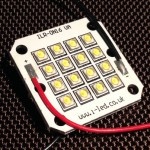|
march, 2015 - cambridge nanotherm has published results of a round of testing of several thermal pcb materials intended for use in leds, including its unique nanoceramic thermal management substrates for leds. the tests were conducted by the lia laboratories (part of the lia – europe’s largest lighting trade association) and showed cambridge nanotherm’s thermal management technology outperforming all the thermal management substrates tested in terms of its thermal conductivity.
the lia laboratories test used 4 x 50 watt intelligent led solutions oslon 16+ powerclusters mounted on four different mcpcb (metal clad pcb) substrates from leading manufacturers including nanotherm lc. the substrates were attached with a tim to a fischer elektronik la 7/150 fan-cooled heat sink (thermal resistance: 0.075°c/w). a precision ea-ps 2084-10b (0-10a; 0-84v) laboratory power supply was used to drive the leds at constant current. thermocouples measured the cluster and heat sink temperature at multiple locations. a calibrated integrating sphere measured the lumens output.
with a drive current of 1,000ma running through the leds, nanotherm lc ran a massive 13.6°c (30%) cooler than the generic chinese mcpcb used as a ‘control’ board. even compared to the closest high-performance board nanotherm lc ran 2.4°c (5%) cooler.
the tests also examined how much extra luminosity could be achieved on nanotherm lc within a given temperature envelope, compared to the nearest competitor. at 1,000ma drive current, leds on the closest high-performance board ran at 39.7°c and delivered a light output of 4760 lumens. when leds on nanotherm lc were run up to this exact same temperature of 39.7°c, the leds were able to handle a drive current of 1,350ma and produced a luminosity of 5896 lumens. in effect, at the same temperature as the competitor board, nanotherm produced a 23.8% increase in brightness. applied to the real world this means nanotherm lc provides a clear path for manufacturers to substantially reduce the number of led dies used in any given design whilst maintaining the brightness.
“the figures don’t lie,” commented ralph weir, ceo, cambridge nanotherm. “the results show cambridge nanotherm’s lc substrate outperforming every other mcpcb that was tested, including what we believe to be the current market leader.”
“our results demonstrate two distinct possibilities, the ability to reduce overall system temperatures, or to run leds at a greater luminosity within a given temperature envelope. both should have led manufacturers very excited. these tests demonstrate comprehensively that our substrates can be used to drive down led costs through die count reduction while maintaining product efficiency and lifetimes. the ability to drive leds harder, cooler and brighter should help forge new application areas.”
“these results demonstrate yet again why nanotherm materials are enjoying such success in the high-power led market. we’re delighted that the lia laboratories, as a fully independent test house, has confirmed that they achieved a 23% increase in brightness from the same leds – just by using nanotherm materials rather than the more expensive options from the most respected “big brand” mcpcb suppliers”.
in high current pulsed operation (20 pulses, 20ms, 2,400ma), the benefit of the higher specific heat capacity of nanotherm lc became apparent, achieving an end-of test die temperature of 8.2°c (21.6%) cooler than all other mcpcbs tested.
under continuous drive at the same high current of 2,400ma, the test had to be stopped after a few minutes as even with this powerful heat sink all but nanotherm exceeded 100°c – the generic chinese mcpcb was a staggering 47.2°c hotter. even the best competitor exceeded 100°c, running 8.6°c hotter than the nanotherm material. at this current nanotherm’s substrate was the only one to keep the leds below 100°c.
this demonstrated that nanotherm lc really comes into its own in more aggressive thermal settings and can make the difference to leds operating within their recommended temperature envelopes or not.

for full article: http://www.camnano.com/lia-laboratories-ltd-tests-show-nanotherm-thermal-management-substrates-running-up-to-47c-cooler-than-competing-solutions/
about
back in the 1990’s, our founders discovered a revolutionary approach for hardening aluminium. working at the university of moscow, they developed a process which converted the surface of aluminium into ceramic. this process was used very successfully to treat mechanical components, bringing a unique combination of the lightness of aluminium with an extremely hard-wearing surface. the surface was porous, which meant that it was ideal for retention of lubricants – and since that time, it has been used widely in industries as diverse as motor racing, packaging, corrosion protection and textiles.
contact
homefield road
haverhill
suffolk
cb9 8qp
united kingdom
t +44 (0)1440 765 520
f +44 (0)1440 765 527
[email protected]
www.camnano.com
|